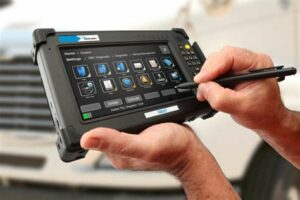Electronic Logging Devices (ELDs) are electronic devices used by commercial motor vehicle (CMV) drivers to record their hours of service (HOS) information. ELDs automatically record  data such as driving time, engine hours, vehicle movement, location information, and more.
data such as driving time, engine hours, vehicle movement, location information, and more.
ELDs replace traditional paper logbooks that drivers previously used to record their HOS information. ELDs make the recording process more accurate and efficient, reducing the likelihood of errors or falsification.
The use of ELDs is regulated by the Federal Motor Carrier Safety Administration (FMCSA) in the United States, and other similar regulatory bodies in other countries. ELDs are mandatory for most CMV drivers and carriers subject to the HOS rules in the United States.
How do Electronic Logging Devices (ELD) work?
Electronic Logging Devices (ELDs) use a combination of GPS technology and data from the vehicle’s engine to keep track of the driver’s hours and location.
The ELD is connected to the engine of the commercial motor vehicle (CMV) and automatically records data such as engine power status, vehicle motion status, and miles driven. The ELD also captures information about the driver’s duty status, including whether they are driving, on duty but not driving, off-duty, or in the sleeper berth.
The GPS technology in the ELD allows it to track the vehicle’s location and the route taken by the driver. This location data is then used to calculate the number of miles driven, as well as the time and duration of the driver’s on-duty and driving periods.
By combining the engine and GPS data, ELDs can accurately track the driver’s hours of service, ensuring that they are complying with federal regulations. ELDs also provide real-time monitoring of the driver’s status, making it easier for carriers to manage their operations and ensure that drivers are not exceeding their HOS limits.
Are Electronic Logging Devices (ELD’s) accurate?
Electronic Logging Devices (ELDs) are designed to be accurate and reliable in recording a driver’s hours of service (HOS). ELDs use GPS technology and data from the vehicle’s engine to record the driver’s duty status, hours worked, and location information.
One of the primary benefits of ELDs is their accuracy in recording a driver’s HOS. ELDs eliminate the need for paper logs, which are often prone to errors and falsification. With ELDs, the driver’s HOS data is automatically recorded, and there is little room for manipulation or error.
ELDs must meet specific technical standards set by the Federal Motor Carrier Safety Administration (FMCSA) in the United States to ensure accuracy and reliability. The FMCSA requires ELDs to be able to automatically record a driver’s duty status, engine power status, vehicle motion status, miles driven, and location information.
ELDs must also be tamper-resistant and meet certain data security requirements. They must have the ability to transmit data to authorized personnel, such as law enforcement or carriers, upon request.
ELDs are designed to be accurate and reliable in recording a driver’s HOS, making it easier for carriers to manage their operations, ensure compliance with federal regulations, and improve road safety.
Have Electronic Logging Devices (ELD’s) reduced accidents? 
Electronic Logging Devices (ELDs) have been shown to have a positive impact on road safety and reduce accidents.
The use of ELDs has been linked to a decrease in the number of hours-of-service (HOS) violations and driver fatigue-related accidents. By accurately recording a driver’s HOS and ensuring that they are taking adequate rest breaks, ELDs can reduce the risk of driver fatigue and related accidents.
A study conducted by the Federal Motor Carrier Safety Administration (FMCSA) in the United States found that carriers that adopted ELDs had an 11.7% reduction in the total crash rate and a 5.1% reduction in the preventable crash rate.
Another study conducted by the FMCSA found that ELDs were associated with a 50% reduction in the risk of hours-of-service (HOS) violations.
The use of ELDs has been shown to have a positive impact on road safety by reducing the risk of driver fatigue-related accidents and ensuring compliance with federal regulations. By improving compliance and reducing accidents, ELDs can also help carriers reduce their liability and insurance costs.
Did the hours of service rules change when electronic logging devices (ELD’s) were mandated?
Yes, the hours of service (HOS) rules did change when electronic logging devices (ELDs) were mandated in the United States.
In December 2015, the Federal Motor Carrier Safety Administration (FMCSA) published a final rule that required the use of ELDs by most drivers who are required to prepare HOS records of duty status (RODS). The final rule included changes to the HOS regulations that were designed to improve safety on the nation’s roads.
Some of the key changes to the HOS rules included:
- Limiting the maximum average workweek for truck drivers to 70 hours, a reduction from the previous limit of 82 hours.
- Requiring drivers to take a 30-minute break after 8 hours of consecutive driving.
- Allowing drivers to “reset” their weekly work limits by taking a continuous 34-hour break, including two periods between 1:00 a.m. and 5:00 a.m.
- Requiring drivers to declare their duty status as on-duty not driving during any period when they are in the sleeper berth of their vehicle.
The use of ELDs has made it easier for drivers and carriers to comply with the HOS regulations by accurately recording their hours and providing real-time monitoring of the driver’s status. This has helped to improve road safety by reducing the risk of driver fatigue-related accidents and ensuring compliance with federal regulations.
Do electronic logging devices encourage drivers to drive while tired? 
ELDs are designed to help prevent driver fatigue by accurately recording a driver’s hours of service (HOS) and ensuring that they are taking adequate rest breaks. The ELDs automatically record a driver’s duty status, including when they are driving, on duty but not driving, off-duty, or in the sleeper berth. By monitoring a driver’s HOS, the ELDs can help ensure that drivers are taking sufficient rest breaks and complying with federal regulations.
Moreover, the use of ELDs has been shown to reduce the risk of driver fatigue and fatigue-related accidents. The FMCSA conducted a study that found that carriers that adopted ELDs had an 11.7% reduction in the total crash rate and a 5.1% reduction in the preventable crash rate. This is because ELDs help ensure that drivers are taking adequate rest breaks and complying with HOS regulations, reducing the risk of driver fatigue-related accidents.
ELDs are designed to help prevent driver fatigue and improve road safety. By accurately recording a driver’s HOS and ensuring that they are taking adequate rest breaks, ELDs can help prevent drivers from driving while tired.


Recent Comments